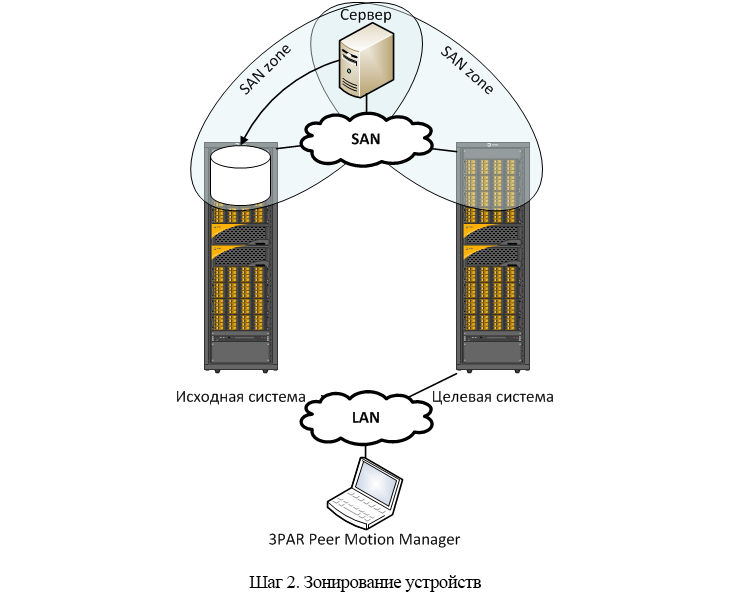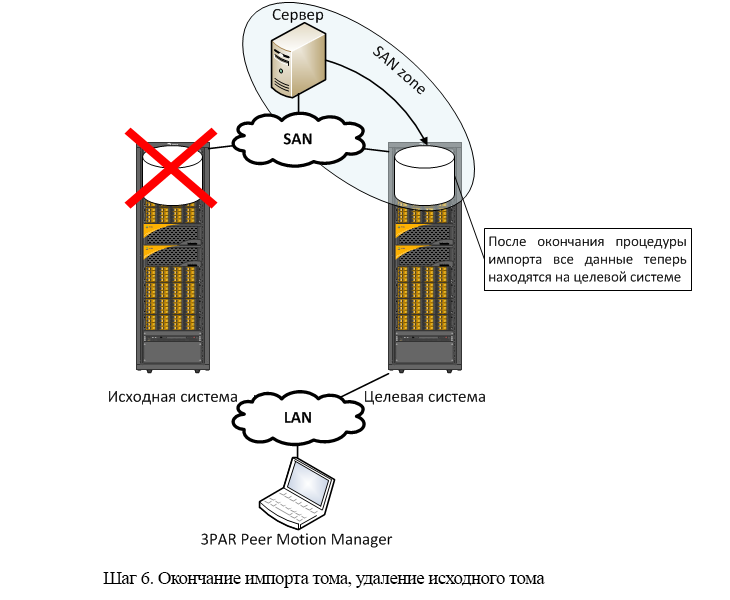Interesting possibilities of storage systems HP 3PAR. Part 3 - Peer Motion
If you still think that data migration from one storage system to another online and without service downtime is possible only with the use of expensive virtualizers (emc vplex, ibm svc), then you will be interested to learn about 3PAR Peer Motion technology, which allows you to solve similar task with lower financial costs and without the use of any additional equipment. This article is a brief description of how 3PAR Peer Motion works and continues the following HP 3PAR topics:
In August 2011, HP 3PAR arrays (version 3.1.1 of InForm OS) had the option of online volume migration between any 3PAR arrays without interrupting server access to data. None of the competitors still have this functionality. 3PAR Peer Motion technology allows you to:
It should be noted that Peer Motion is by no means a competitor of virtualizers - these are completely different technologies with different capabilities and with a large difference in the cost of the solution.
For the correct migration procedure, we need the following things:

')
After all the preparatory procedures, the first thing you need to do is zoning on the Fiber Channel switches. The server whose data we are migrating should see both disk arrays.

At this stage, it's time to launch Peer Motion Manager and select the following items from the menu:
From this point on, a volume through the target system will be created and automatically exported (path through volume) with exactly the same unique identifier (WWID) as on the source system. After rescanning on an I / O bus server, the number of paths on the server to the volume should double. That is, the target system can now also process IO server requests. It will forward all incoming requests to it to the original system.

In the event that the volume we are migrating is the only one for our server, then at this stage we can already remove the zone between the server and the source system on the Fiber Channel switches and also rescan the I / O bus to remove the old paths to the volume. .

To transfer the volume from the source system to the target one, select “Import Volumes to Destination Array” in the Peer Motion Manager. At this step, you also need to select a group (CPG) to which the volume data and some additional options will be transferred (for example, converting the volume from thick to thin). Importing a volume will also temporarily affect performance.

When the volume is imported, Peer Motion will automatically break the link between the original and the imported volume. Data changes will be recorded only to the imported volume on the target system, and the original system will remain on the source system until the migration is completed. To delete a volume on the source system in Peer Motion Manager, select the “Cleanup Migration Host” item.

That's all! As you can see, the online migration of the volume to the HP 3PAR is quite simple.
- Interesting possibilities of storage systems HP 3PAR. Part 1 - Persistent Ports
- Basics of thin allocation of volumes on storage systems (or anniversary 3PAR thin provisioning)
Why do I need Peer Motion
In August 2011, HP 3PAR arrays (version 3.1.1 of InForm OS) had the option of online volume migration between any 3PAR arrays without interrupting server access to data. None of the competitors still have this functionality. 3PAR Peer Motion technology allows you to:
- Perform online transfer of volumes between two 3PAR storage systems for load balancing or for the purpose of migration from the old storage system to the new one without stopping the application
- Convert volume when migrating from thick to thin on the fly
- For online data migration there is no need to change server settings or install additional software there.
It should be noted that Peer Motion is by no means a competitor of virtualizers - these are completely different technologies with different capabilities and with a large difference in the cost of the solution.
How is the procedure of migration
Step one. Training.
For the correct migration procedure, we need the following things:
- Two HP 3PAR disk arrays. The microcode version on the source system is not lower than 2.2.4, on the target one not lower than 3.1.1. Disk arrays must be interconnected by at least two links.
- A Windows host that has the PMM (Peer Motion Manager) script installed and that has network access to the target storage system.
- Peer Motion license on target system.
- The server for which the online migration procedure is performed must be connected to the arrays via the SAN network. Direct connections are not supported.

')
Step two. Zoning
After all the preparatory procedures, the first thing you need to do is zoning on the Fiber Channel switches. The server whose data we are migrating should see both disk arrays.

Step three. Path-through volume
At this stage, it's time to launch Peer Motion Manager and select the following items from the menu:
- Online Migrate Volumes
- Select Host, Export, and Admit Volumes to Destination Array
- Enter the name of the server for which you are migrating
From this point on, a volume through the target system will be created and automatically exported (path through volume) with exactly the same unique identifier (WWID) as on the source system. After rescanning on an I / O bus server, the number of paths on the server to the volume should double. That is, the target system can now also process IO server requests. It will forward all incoming requests to it to the original system.

Step Four. Zoning
In the event that the volume we are migrating is the only one for our server, then at this stage we can already remove the zone between the server and the source system on the Fiber Channel switches and also rescan the I / O bus to remove the old paths to the volume. .

Step five. Data Migration.
To transfer the volume from the source system to the target one, select “Import Volumes to Destination Array” in the Peer Motion Manager. At this step, you also need to select a group (CPG) to which the volume data and some additional options will be transferred (for example, converting the volume from thick to thin). Importing a volume will also temporarily affect performance.

Step Six. Completion of migration.
When the volume is imported, Peer Motion will automatically break the link between the original and the imported volume. Data changes will be recorded only to the imported volume on the target system, and the original system will remain on the source system until the migration is completed. To delete a volume on the source system in Peer Motion Manager, select the “Cleanup Migration Host” item.

That's all! As you can see, the online migration of the volume to the HP 3PAR is quite simple.
Source: https://habr.com/ru/post/173037/
All Articles